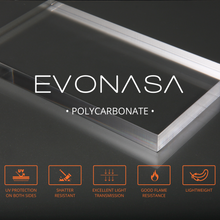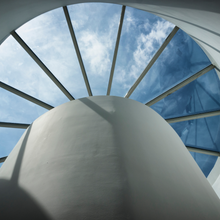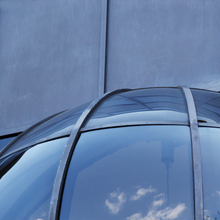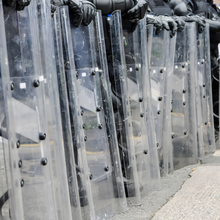FREE DELIVERY (1-2 working days)
Evonasa's Flat Polycarbonate sheet has incredible material properties that ultimately out perform glass and other thermoplastics. It's perfect for applications such as fabrication, signage, display, screens and glazing.
Compared with glass, this extruded flat polycarbonate glazing sheet is approximately half the weight, provides close to 200 times greater impact resistance and matches light transparency.
Evonasa's Flat Polycarbonate sheet offers UV protection on both sides. With this enhancement, it can withstand extreme conditions and its life expectancy is significantly extended.
POLYCARBONATE SHEET
• MATERIAL BENEFITS •


• SECURITY •
&
• IMPACT RESISTANCE •
Evonasa's flat polycarbonate sheet is shatter resistant and is perfect for applications where reliability and extreme performance are required.
- 200 times greater strength compared with glass.
- Glass comparable light transmission.
- Chemical resistant.
• LONG LIFE •
&
• UV PROTECTION •
Evonasa's flat polycarbonate sheet provides UV protection on both sides and in doing so, drastically reduces UV transmission. Apart from providing protection against harmful UV radiation, this feature aids with significantly increasing the length of its life.
- Perfect for use outside in demanding climates.
- Prevents discolouration of the sheet.
- Increased sheet life expectancy.
- Helps maintain strength and a high level of light transmission.


• LIGHT TRANSMISSION •
Evonasa's clear polycarbonate sheet delivers high optical clarity which allows it to be a fantastic glazing material. The light transmission varies depending on the thickness of the material (84% - 89%).
• SIMPLE INSTALLATION •
&
• LIGHTWEIGHT •
Evonasa's polycarbonate sheet is approximately half the weight of glass. Increased spanning capability and a reduction in the quantity of required supporting structures results from the rigidity and strength of this material.
- Can be cut-to-size on-site.
- Can be installed both ways due to being UV protected on both sides.


• DESIGN OPTIONS •
Evonasa's polycarbonate sheet can be thermoformed, cut and cold curved allowing architects and designers to implement incredibly creative ideas. It's perfect for glazing solutions for domes, skylights, greenhouses, covered walkways. windows, shields, sunrooms, car ports etc.

• FIRE PERFORMANCE •
| ESSENTIAL CHARACTERISTS | PERFORMANCE | HARMONISED TECHNICAL SPECIFICATION |
|---|---|---|
| External fire performance | FROOF(NPD) | EN 16240:2013 |
| Reaction to fire | B, s1 d0 | EN 16240:2013 |
| Resistance to fire | NPD | EN 16240:2013 |
POLYCARBONATE SHEET
• APPLICATIONS •


• SECURITY & SAFETY •
Applications include:
- Bus shelters
- Protective visors
- Bus windows
- Clean rooms
- Prison windows
- Vending equipment
- Shields for security and police forces
- Security glazing
• FABRICATION •
Applications include:
- Visors
- Riot shields
- Domes
- Roof lights
- Vending equipment


• GLAZING & CONSTRUCTION •
Applications include:
- Greenhouses
- Sound barriers
- Canopies
- Designer roofing
- Sunrooms
- Protective screens
- Car ports
- Skylights
• PRINT & DISPLAY •
Applications include:
- Illuminated signage
- Point of sale
- Light fixtures
- Signage
- Displays
- Poster covers

POLYCARBONATE SHEET
• INSTALLATION •


• ROUTING •
CNC machining or hand held routers can be used to simply cut Evonasa's flat Polycarbonate sheet. Notches should be avoided as this may lead to cracking of the sheet. Milling machines with high speed tools can be used to machine the polycarbonate sheet. To prevent a poor finish due to vibration, it's essential that the sheet is securely held during machining.
• STORAGE & HANDLING •
Storage of polycarbonate sheets should be indoors if possible. If this is not possible, ensure that the sheets are suitably covered to protect from water/rain and sunlight. Store the sheets horizontally on a dry and flat surface and preferably on fit for purpose pallets. Avoid stacking the pallets to a height of greater than 1 meter and avoid stacking sheets of different lengths and width in the same stack.


• COLD CURVING •
Cold curving of Evonas's Polycarbonate sheet is very simple. To calculate the minimum bending radius in millimetres, multiply 150 by the thickness of the sheet in millimetres (eg 150 x 2mm thickness = 300mm). If you're unsure, please refer to the values mentioned in the table in the 'material properties' section of the brochure.
• DRILLING •
The preferred drilling bit for drilling polycarbonate sheet is a thermoplastic specific bit. Non specially ground metal bits can be used but are not preferred. Avoid using cutting oils and countersinking fixings.


• OPERATING TEMPERATURE •
The operating temperature range for polycarbonate sheet is -20 degrees celsius to 100 degrees celsius.
• CUTTING •
Conventional workshop equipment (e.g. circular saw or band saw) can easily cut and saw Evonasa's flat polycarbonate sheet.


• CLEANING •
Panel surfaces can be kept clean using warm water, a few drops of liquid detergent and a new chamois or microfibre cloth changing regularly to reduce the chance of transferring dirt, dust or particles. Harsh and volatile chemicals and cleaners are not required and may cause scratching or crazing.
• VACUUM FORMING •
When vacuum forming polycarbonate sheet, the best results are achieved when both sides of the sheet are heated in a controlled manner. Larger panels may require air pressure support during heating to minimise sag. Ensure the sheet is pre-dried and the film is removed prior to drying. When vacuum forming, the sheets should be oriented vertically and air should be allowed to circulate.


• HOT LINE BENDING •
Temperatures between 155 and 165 degrees celsius are recommended during hot line bending. Ensure that the area heated is approximately 5 times as wide as the sheet is thick. For thicknesses greater than 4mm ensure the heating is applied to both sides. Always utilise a former radius that is greater than or equal to the thickness of the sheet. Avoid the creation of sharp internal corners.
• PRINTING •
Reverse printing is usually implemented to ensure a glossy exposed surface and to allow the use of non UV stabilised inks. Ensure that the inks/paints being utilised are chemically compatible with the polycarbonate sheet. It's good practise to provide good ventilation during the drying phase.


• BONDING •
When bonding polycarbonate sheet, Hot Melt, Polyurethane, Silicone or Epoxy are suggested. It's always good practise to follow the advice of your adhesive supplier with regards to it being fit for purpose.
• THERMOFORMING •
Prior to thermoforming polycarbonate sheet, remove the film and pre-dry at an approximate temperature of 120 degrees celsius. Ensure that thermoforming is carried out straight after the drying phase. The most efficient ovens are those that circulate air between sheets and can control the temperature accurately. Standard vacuum or pressure forming equipment can be used for moulding. Temperatures between 175 and 200 degrees celsius are required for forming.

POLYCARBONATE SHEET
• MATERIAL PROPERTIES •

OFFICIAL SUPPLIER TO:














